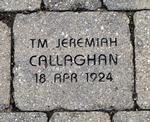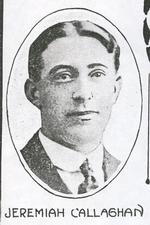Firefighter Record
Firefighter Details
| Name | Jeremiah Callaghan |
| Agency | Chicago Fire Department |
| Rank | Truckman |
| Type of Firefighter | Career |
| Age Range | [Unknown] |
| Sex | Male |
| Date of Birth | 0/0/0 |
| Date of Death | 4/18/1924 |
| Cause of Death | Struck by object |
| Nature of Death | Trauma |
| Attribute of Death | [not applicable] |
| Type of Duty | Firefighting operations , Ladder operations |
Incident Details
| Incident Name | Curran's Hall Fire |
| Incident City | Chicago |
| Incident State | IL |
| Incident Date | 4/18/1924 19:0 |
| Incident Location | Store/Office , Industry/ Manufacturing |
| Incident Attribute | Structural collapses , Explosions , Arson , Fires |
Incident Summary
On April 18, 1924, an arson fire destroyed Curran’s Hall, a four-story commercial building on Blue Island Avenue in Chicago. Eight Chicago Fire Department firefighters died, and more than twenty were injured, when the walls of the building collapsed during firefighting operations. A ninth firefighter died from his injuries eight days after the fire, and one civilian also died while trying to help rescue firefighters from the rubble.
Truck 12 lost six firefighters in the collapse: Lieutenant Frank Frosh, Firefighter Edward Kersting, Firefighter Samuel T. Warren, Firefighter Thomas W. Kelly, Firefighter Jeremiah Callaghan, and Firefighter James Carroll, the last of whom died from fatal injuries on April 26. In addition, Engine 5 lost two firefighters, Captain John Brennan and Firefighter Michael Devine, and Firefighter Francis Leavy of Engine 107 also died in the collapse.
Firefighters arrived on scene shortly after the fire was discovered around 7PM by an off-duty streetcar conductor who noticed flames coming out of the front and roof of the building. As firefighters arrived, the building watchmen noticed a stream of burning liquid flowing toward two boxes sitting on a stairwell. When the flames reached the boxes, they exploded. Chief Michael Kerwin of Battalion 7 witnessed a similar anomaly during his initial size-up, when he noticed flames spreading down a stairwell in the manner of an oil fire. He also identified two distinct and suspicious points of origin on opposite sides of the building, and called in a 4-11 alarm.
Firefighters from Engines 5 and 107 were operating hose lines inside of the building and Firefighters from Truck 12 were operating from ladders placed against the front of the building when the roof collapsed. As the roof fell in, it pushed the building’s walls outward, and the roof and top two floors fell into the heart of the fire. Dozens of firefighters were caught in an avalanche of bricks and debris, and Engines 5 and 107 were also buried by debris. A brand new water tower apparatus was also destroyed in the collapse, and eight other apparatus sustained damage.
Within thirty minutes of the collapse, every rescue agency in Chicago was called upon to help rescue and care for the trapped and injured firefighters. Rescue work was hindered, however, because the falling walls had knocked out power lines, throwing the whole neighborhood into darkness. Search crews nevertheless worked throughout the night to rescue trapped firefighters and to recover the bodies of those killed in the collapse.
Funerals for the fallen firefighters were held on April 21, 22, and 23, and 125 Chicago firefighters were officially detailed to serve as honorary escorts for the services. For the first time in history, the Chicago Fire Department also officially honored William Behr, the civilian who died while trying to help rescue the trapped firefighters, when six firefighters served as honorary pallbearers for his funeral.
In the years after the fire, the owners of a sporting goods and novelties company housed on the second floor of Curran’s Hall were charged with and convicted for murder and arson. They had spread wood alcohol throughout the building and started the fire to cash in a $32,000 insurance policy.
Citations:
“7 Fireman Die Under Wall,” Chicago Daily Tribune, April 19, 1924.
“Firebug Theory Gains as Official Inquiry Opens,” Chicago Daily Tribune, April 19, 1924.
“Seven Fireman Are Known to Have Been Killed and Many Were Injured When Huge Wall Collapses,” Chicago Daily Tribune, April 19, 1924.
“Arson Seen as Cause of Fire in Curran Hall,” Chicago Daily Tribune, April 20, 1924.
“City, County, and State Officials Join in Fire Inquiry,” Chicago Daily Tribune, April 20, 1924.
“Glimpses of Havoc Wrought by Curran Hall Fire,” Chicago Daily Tribune, April 20, 1924.
“Revised Roster of Those Who Died in Curran Hall Fire,” Chicago Daily Tribune, April 20, 1924.
“Set Funerals of Heroic Dead in Curran Fire,” Chicago Daily Tribune, April 21, 1924.
“Coroner Rushes Preparation of Arson Evidence,” Chicago Daily Tribune, April 22, 1924.
“Death by Arson Should Mean Death by Rope,” Chicago Daily Tribune, April 23, 1924.
“‘Arson-Murder’ Jury’s Verdict Against Firm,” Chicago Daily Tribune, April 23, 1924.
“Indictments in Arson Case for Murder Voted,” Chicago Daily Tribune, May 9, 1924.
“Two on Trial for Ten Firemen’s Deaths in Blaze,” Chicago Daily Tribune, May 16, 1926.

